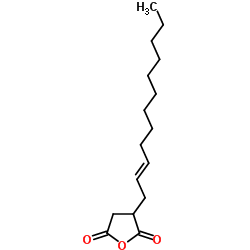2-dodecen-1-ylsuccinic anhydride

2-dodecen-1-ylsuccinic anhydride structure
|
Common Name | 2-dodecen-1-ylsuccinic anhydride | ||
|---|---|---|---|---|
| CAS Number | 26544-38-7 | Molecular Weight | 266.376 | |
| Density | 1.0±0.1 g/cm3 | Boiling Point | 348.4±0.0 °C at 760 mmHg | |
| Molecular Formula | C16H26O3 | Melting Point | 41-43 °C(lit.) | |
| MSDS | Chinese USA | Flash Point | 177.8±0.0 °C | |
| Symbol |

GHS07 |
Signal Word | Warning | |
|
Ectopic lignification in the flax lignified bast fiber1 mutant stem is associated with tissue-specific modifications in gene expression and cell wall composition.
Plant Cell 26(11) , 4462-82, (2014) Histochemical screening of a flax ethyl methanesulfonate population led to the identification of 93 independent M2 mutant families showing ectopic lignification in the secondary cell wall of stem bast fibers. We named this core collection the Linum usitatissi... |
|
|
Extracellular matrix modulates the biological effects of melatonin in mesenchymal stem cells.
J. Endocrinol. 223(2) , 167-80, (2014) Both self-renewal and lineage-specific differentiation of mesenchymal stem cells (MSCs) are triggered by their in vivo microenvironment including the extracellular matrix (ECM) and secreted hormones. The ECM may modulate the physiological functions of hormone... |
|
|
Dodecenylsuccinic anhydride derivatives of gum karaya (Sterculia urens): preparation, characterization, and their antibacterial properties.
J. Agric. Food Chem. 63(14) , 3757-65, (2015) Esterifications of the tree-based gum, gum karaya (GK), using dodecenylsuccinic anhydride (DDSA) were carried out in aqueous solutions. GK was deacetylated using alkali treatment to obtain deacetylated gum karaya (DGK). The DGK and its DDSA derivative were ch... |
|
|
Small interfering RNA delivery by polyethylenimine-functionalised porous silicon nanoparticles.
Biomater. Sci. 3 , 1555-65, (2015) In this study, thermally hydrocarbonised porous silicon nanoparticles (THCpSiNPs) capped with polyethylenimine (PEI) were fabricated, and their potential for small interfering RNA (siRNA) delivery was investigated in an in vitro glioblastoma model. PEI coatin... |
|
|
Musculoskeletal anatomy and feeding performance of pre-feeding engyodontic larvae of the European eel (Anguilla anguilla).
J. Anat. 227 , 325-40, (2015) Being part of the elopomorph group of fishes, Anguillidae species show a leptocephalus larval stage. However, due to largely unknown spawning locations and habitats of their earliest life stages, as well as their transparency, these Anguilla larvae are rarely... |
|
|
Silver nanoparticles: correlating nanoparticle size and cellular uptake with genotoxicity.
Mutagenesis 30 , 577-91, (2015) The focus of this research was to develop a better understanding of the pertinent physico-chemical properties of silver nanoparticles (AgNPs) that affect genotoxicity, specifically how cellular uptake influences a genotoxic cell response. The genotoxicity of ... |
|
|
Toxicity of 11 Metal Oxide Nanoparticles to Three Mammalian Cell Types In Vitro.
Curr. Top. Med. Chem 15 , 1914-29, (2015) The knowledge on potential harmful effects of metallic nanomaterials lags behind their increased use in consumer products and therefore, the safety data on various nanomaterials applicable for risk assessment are urgently needed. In this study, 11 metal oxide... |
|
|
Nose-to-Brain Delivery: Investigation of the Transport of Nanoparticles with Different Surface Characteristics and Sizes in Excised Porcine Olfactory Epithelium.
Mol. Pharm. 12 , 2755-66, (2015) The ability to deliver therapeutically relevant amounts of drugs directly from the nasal cavity to the central nervous system to treat neurological diseases is dependent on the availability of efficient drug delivery systems. Increased delivery and/or therape... |
|
|
Detection of organic nanoparticles in human bone marrow-derived stromal cells using ToF-SIMS and PCA.
Anal. Bioanal. Chem 407 , 4555-65, (2015) The detection and localization of polymer-based nanoparticles in human bone marrow-derived stromal cells (hBMSC) by time-of-flight secondary ion mass spectrometry (ToF-SIMS) is reported as an example for the mass spectrometry imaging of organic nanoparticles ... |
|
|
Sp1/Sp3 transcription factors regulate hallmarks of megakaryocyte maturation and platelet formation and function.
Blood 125 , 1957-67, (2015) Sp1 and Sp3 belong to the specificity proteins (Sp)/Krüppel-like transcription factor family. They are closely related, ubiquitously expressed, and recognize G-rich DNA motifs. They are thought to regulate generic processes such as cell-cycle and growth contr... |